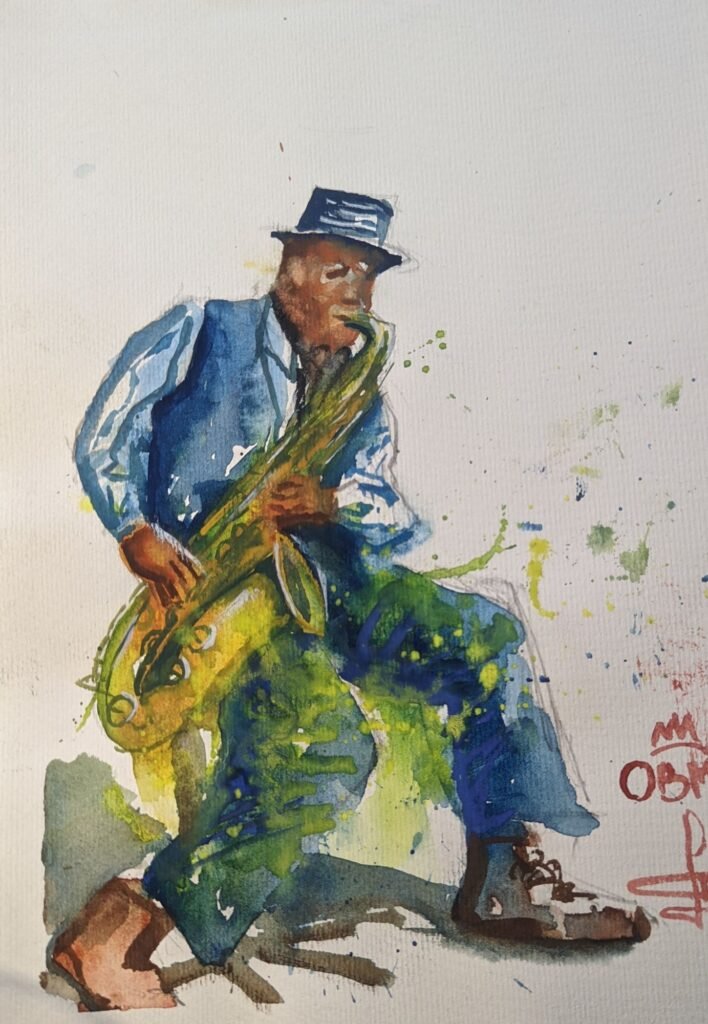
In the realm of artistic expression, music and visual art often intertwine, each medium amplifying the emotional resonance of the other. Today, we turn our gaze and our ears towards a captivating watercolor painting titled “Afro Saxman.” Rendered with the fluid grace of watercolor on paper, sized at an intimate 8.3 x 11.7 inches, this artwork is more than just a portrait of a musician; it’s a vibrant homage to the spirit of Afrobeat, a genre born from a potent fusion of sounds and a powerful assertion of African identity.
The painting captures a solitary figure, a musician completely absorbed in his craft. Seated with his saxophone, he embodies the essence of musical dedication. The artist’s choice of a light blue shirt, a darker blue vest, and a stylish fedora evokes a sense of classic cool, reminiscent of the jazz and highlife influences that would later coalesce into Afrobeat. The warm brown tones used for his skin suggest a connection to the African continent, a heritage deeply woven into the fabric of the music he plays.
The saxophone itself, rendered in lively yellows and greens, becomes an extension of the musician’s soul. The flowing brushstrokes capture its iconic curves and intricate mechanics, almost allowing us to hear the brassy notes that might be filling the air. The musician’s posture, leaning into the instrument with focused intent, speaks to the passion and energy inherent in Afrobeat performances.
While the background remains largely unadorned, expressive splatters and washes of blue, green, and yellow seem to radiate from the figure, visually representing the vibrant and infectious rhythms of the music. These abstract elements hint at the energy and dynamism that define the Afrobeat sound, a sound that has captivated audiences across the globe.
To truly appreciate “Afro Saxman,” we must delve into the rich history and cultural significance of Afrobeat. Born in the bustling streets of Lagos, Nigeria, in the 1960s and 1970s, Afrobeat was the brainchild of the legendary Fela Anikulapo Kuti. Fela, a musical innovator and a fierce social and political activist, synthesized a unique sound that drew inspiration from a diverse range of musical traditions.
He masterfully blended the intricate polyrhythms of traditional Yoruba music with the improvisational structures of jazz, the infectious grooves of highlife, and the politically charged lyrics inspired by the Black Power movement. The result was a genre that was both sonically groundbreaking and deeply rooted in the African experience.
Afrobeat was more than just music; it was a cultural and political force. Fela’s lyrics fearlessly addressed issues of corruption, colonialism, and social injustice, making his music the voice of the disenfranchised. His sprawling, hypnotic compositions, often exceeding ten minutes in length, were punctuated by powerful horn sections, intricate guitar riffs, and Fela’s charismatic vocals and saxophone solos.
The saxophone, as depicted in the artwork, played a crucial role in the Afrobeat sound. Often taking center stage in extended instrumental breaks, the saxophone in Afrobeat was both melodic and percussive, weaving through the complex rhythmic tapestry with soulful cries and energetic bursts. Musicians like Fela himself were virtuosos of the instrument, using it to convey both raw emotion and intricate musical ideas.
The legacy of Afrobeat extends far beyond its Nigerian origins. The genre has influenced countless musicians worldwide, its infectious rhythms and socially conscious lyrics resonating with artists across diverse cultures. From its early pioneers to contemporary artists who continue to push its boundaries, Afrobeat remains a vibrant and evolving musical force.
“Afro Saxman” serves as a poignant visual representation of this powerful musical heritage. The solitary figure with his saxophone embodies the dedication, passion, and soulful expression that are at the heart of Afrobeat. The painting invites us to not only admire the artistic skill of the watercolor rendering but also to connect with the rich cultural history and enduring legacy of a genre that continues to move and inspire. It is a tribute to the “Father of Afrobeat” and the countless musicians who have carried the torch of this revolutionary sound, a sound that continues to pulse with the heartbeat of Africa.
6 Comments
Aisha · April 30, 2025 at 9:25 am
Very informative. But why is fela the only representation of the Afro beats. I think lagbaja need more recognition and appreciation too , he has also done very well in the African music genre.
Abdulrahman Aderibigbe · April 30, 2025 at 9:27 am
You are right 👍
Fatima · April 30, 2025 at 1:47 pm
This piece is exquisite, with intricate pricision and luminous dept. A work well done.
Abdulrahman Aderibigbe · April 30, 2025 at 1:48 pm
Thanks so much
Sudais Habib · May 2, 2025 at 1:40 am
This is Amazing! Well done👍🏾
Abdulrahman Aderibigbe · May 2, 2025 at 7:43 am
Thanks soo much kindly check other interesting blogs on the page